THIS... is Italy (*)
and not just Italy, of course.
Phase 1 was lockdown. Phase 2 (from around May 10th to June 2nd) was “let’s pretend it’s almost over, just to see what happens”. Now, Italy is in Phase 3, that is “let’s open with masks and distance, hoping money will return”.
Daily life now
Loonies are out. Now that is safer, the few who really are anti-healthcare, anti-masks, etc… can finally make themselves easily recognizable, while breathing on each other that they won’t tolerate restrictions:
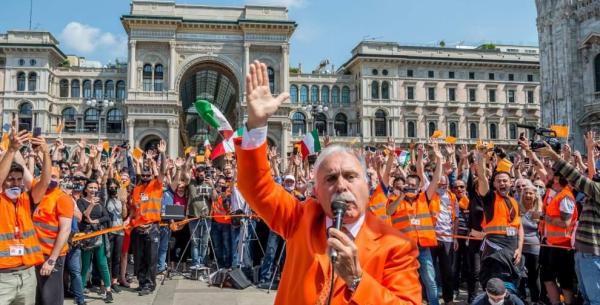
Designer masks are in! This is an ad by a custom-tie designer shop in Rome:

Masks are required in indoor public places, outdoor when physical distancing is not possible, and inside cars, if traveling with people you are not living with.
Store opening hours are chaotic:
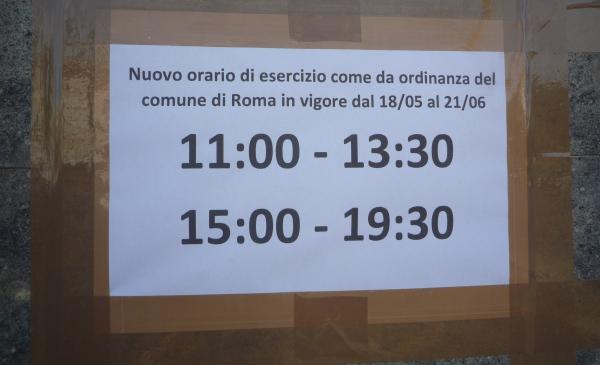
On May 20th, I spent one hour walking around my neighborhood, just to learn the new opening hours that each different category of stores must have, to reduce crowding. It’s easier with movie theathers: in Rome, only one every 25 reopened, due to obscure, or too expensive rules.
Investigations accelerate: Several judges are looking into the errors that contributed to so many deaths in Lombardy, especially by not making “red zones” of some towns. This week, prosecutors questioned PM Conte, and the Italian Court of Auditors started a similar investigation in Umbria, another italian region.
Prices increased, partly because many stores cannot afford to reopen without financing. Businesses that find the money to make COVID-19-resistant their facilities now, can claim 60% of it back, up to 60K Euros, in their tax return NEXT year. A cup of Espresso can cost 20 to 50% more than before, haircuts and similar have increased 25% on average. Bycicles are even worst. In Rome, bycicle stores can’t keep up with a demand that is 200% higher than in 2019, by people who cannot use cars, but want (or have, as I anticipated last month), to avoid buses and subways. Regardless of prices, it’s much easier to find drugs than alcohol to sanitize one’s home these days.
No money yet. Many of the millions of people who were furloughed, laid off, or otherwise left without income since March 8th (including my wife), have seen little or nothing of the money they are officially entitled to, be it unemployment insurance, or aid packages: in the latter case, a frequent reason is that the money only goes, in practice, to people who were already pretty poor in 2018.
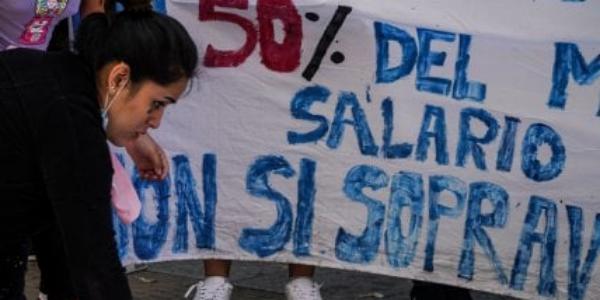
A woman preparing a sign that reads: Nobody can survive with HALF MY SALARY.
</em></u>
Some Fiumicino Airport workers with 24/7/365 shifts are still waiting for unemployment insurance because the software that calculates its exact amount can only handle 9-to-5, Monday to Friday working hours: in their case, some welfare employee must manually “translate” the shifts to that “format”, before they can get paid.
Surprisingly, only 20% of Italians is planning a summer trip , which partly explains why some region governors lost their marbles (see below).
Amateur basket and soccer go contactless, professional women soccer gets lost. In Abruzzo, amateurs can rent fields to play basket or soccer, as long as they play without “deliberately touching each other, or spitting, except in disposable napkins”. The women soccer A league, instead, just quit without declaring a winner, because the clubs, players union and TV networks couldn’t agree on how to continue.
Risky behaviour, and how to avoid it. A poll published on May 20th on post-lockdown fears and expectations found that 23% of Italians (together with English and Spanish) engaged more than before in risky behaviour, from unprotected sex to delaying medical checks. Luckily, people can still fight anxiety on a budget, at least in Rome, buying anti-stress colouring books like these in newspaper kiosks:

TITLE: F**K THE VIRUS, COLOUR HOW F**K YOU WANT!
</em></u>
Knowing what to do was complicated, and still is. When lockdown started, transparency and clear directives lost to both the urgency (unavoidable) and the institutional confusion that was there way before COVID19. An analysis of public acts (1, 2) found that, from early March to May 7th, there were seventy-three decrees or regulations from the Ministry of Health, fifty-nine from Civil Protection (the italian FEMA, so to speak), twenty-one from the Prime Minister Office, eleven from the Special Commissioner for Coronavirus, nine from the High Institute for Health. Plus the local decrees by every one of the 20 italian regions.
I found meaningful COVID19 statistics, at last. Most figures that italian and foreign media publish daily range from unhelpful to misleading. A pleasant exception is the Financial Times tracker, that on May 28th, for example, showed how UK suffers second-highest death rate from coronavirus, and generally made it easier to compare Italy’s situation with that of other countries (including Sweden and its no-lockdown strategy):

Beach time, finally! The city of Rimini ruled that managed beaches cannot have more than one beach umbrella every 18 square meters, and must be open at night too, to reduce crowding. There are managed beaches just south of Rome that ask 1500 Euros to rent one beach umbrella and two beach loungers throughout August.
In mid May, the beaches of Rome were opened to “swimming only, no sunbathing”. Now, the same beaches are open, but filled with rows of poles that mark where people may place their towels. This is how they looked on June 7th, that is …

<u><em><strong>CAPTION:</strong>
<a href="/img/public-beaches-detail.jpg" target="_blank">(Click for detail)</a>
</em></u>
…two days before a storm took many of those poles down.
Children adopted abroad can finally reach Italy. Summer recreation centers for children can reopen from June 15th, with tons of restrictions.
Voting games loom ahead. Two months ago, I argued how and why COVID19 came too late for some elections. Even in 2020, the pandemic has canceled or postponed elections or referedums in 56 countries. In May, Italians should have voted to renew seven regional parliament and governors, about one thousand city councils and one referendum to reform the national Senate. COVID19 has moved all this to one single voting day in September, and opened the door to dangerous experiments with electronic, or even online voting (to see why “dangerous”, just read here).
The three most embarrassing post-lockdown moments (so far, of course)
COVID-9.5. Italians were sure that none of us had mastered the notorious “R0 transmission rate” better than Giulio Gallera, healthcare councillor of Lombardy, the italian region hit hardest by the pandemic. We were wrong.

TRUST THIS MAN WITH YOUR HEALTH, HE GETS NUMBERS!
</em></u>
On May 22nd, Gallera said that “R0 equal to 0.5 means that, in order to get COVID19, you must meet simultaneously TWO people already infected”. Yes, he basically said that to get infected you should get half the virus from one of those people, and half from the other one: COVID-9.5. Four days after, that is at least three months too late, Gallera was “commissariato” that is “not sacked yet, still paid, but can’t even sign a birthday card without approval”.
(Vanished) Vigilantes. In the last days of May, the Minister for Regional Affairs announced (without telling the Minister of Interior, who is responsible for law and order) the intention to enlist 60 thousands volunteer “civic assistants”, who would patrol parks and other public places to remember people to respect physical distancing. Outrage and trolling ensued, covering all the conceivable variants of “the last thing that we need and could actually work here is vigilantes like these”. As of June 10th, the whole proposal seems vanished.
“I won’t give you my tourists” tantrums. On June 3rd, borders among regions were opened again, and a short war among new poors erupted. The governor of Sardinia said he wouldn’t allow tourists from Lombardy to come, without some “no-COVID19” certification to prove their health. The outraged governor of Lombardy shouted “we will remember this when planning our vacations!": which, as everybody but him noticed, is exactly what is colleague in Sardinia was asking. The governor of Calabria said “Hey Lombardy, no problem, come to us!”.
The Foreign Minister was equally smart. When Greece said they wouldn’t accept Italian tourists until July, he vehemently protested that “we will fight to make sure these decisions are taken only at EU level”. In other words, none of these high officials seemed to grasp that a simple “Dear foreign tourists, we welcome you. Dear Italians who voted for me, if others don’t want you who cares? Just vacation as close to home as possible” may be the smarter business strategy for a country like Italy in 2020. Countries that boycott WHO guidelines should probably treated differently, though.
The EU seems to get it now
EU seems much more aware than one month ago that the situation of all Europe is bad. Pressures from France and Germany, due to their own economic forecasts, played a big part in this. As a consequence, there are mountains of money waiting to leave EU coffers. Three of the main special programs discussed, or about to start, should be:
- SURE (Support to mitigate Unemployment Risks in an Emergency)
- 340 billions Euros for Pandemic Crisis Support
- Next Generation EU that is 750 billion Euros for the economic recovery of EU members, of which 500 billion as grants, 250 billion as long term loans
This chart shows how most of the billions to repair economic damage may be divided.
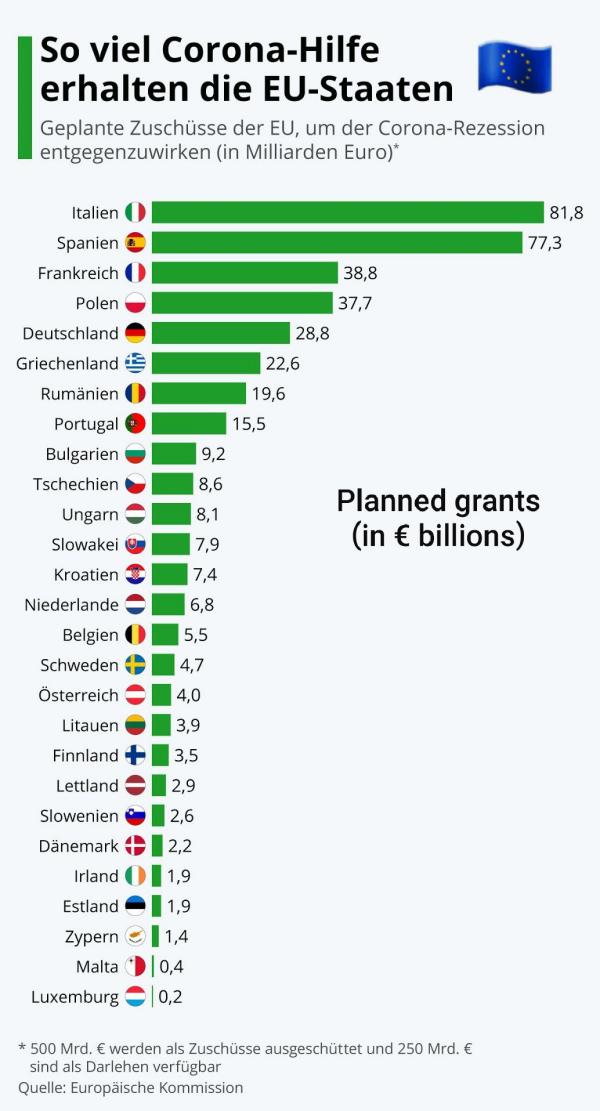
According to this comment, about 90 of the 250 billions above should go to Italy, that is 90% of what Italy may need to borrow on the market in 2021. Again, this is what is under discussion now. The good part is that most of EU seems to have grasped the actual seriousness of the situation, in and outside Italy. The bad part is at least three whole herds of elephants in the room: the conditions coming with any of that money (“We will be treated worse than Greece in 2011, Italy will be sold to foreigners!"), how much of that money will end up in fiscal havens or otherwise wrong places, and how much will just come too late to help people.
Meanwhile, the italian economy is a war zone
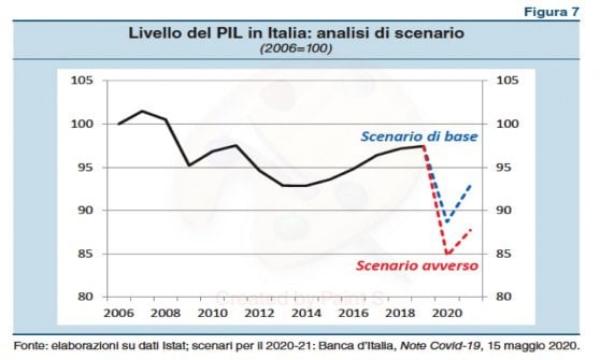
An estimate of italian GDP trend (Scenario avverso = worst case forecast)
</em></u>
My previous lockdown reports said much about the crash of tourism, because that was what collapsed more quickly and more visibly. The italian economy, however, is much more than tourism, and now we have a much better idea of what “much more” means.
In 2020, italian GDP will decrease between 9 and 13%, more if there is another outbreak in the fall. Families in the poorest quintile will lose, percentually, twice as much as those in the richest one. In April 2020, industrial production decreased 19.1% from March, 42% year-on-year: ZERO cars produced in the whole month, 80% reduction of textile/clothing sector. February-to-March, the reduction had been 28.4%. In some sense, the country keeps going because the European Central Bank has been buying lots of italian bonds (source), but of course it is in good company:

Last but not least, a quote from an unknown woman I overheard yesterday, in the queue of a public office: "[All these dificulties] are NOTHING. Wait till August, when the government-imposed, countrywide freezing of layoffs ends. THEN, you will see the REAL hunger."
The plan that wasn’t
Back in April, or May, the government called Vodafone ex–manager Vittorio Colao to lead a committee of experts that would sketch a plan to rebuild Italy’s economy. In early June, the committee published 102 proposals grouped as in this infographic:
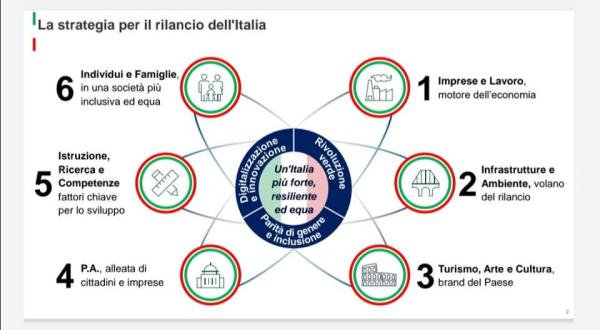
that lists as priorities, from 1 to 6: companies/labour, infrastructures/environment, tourism/art/culture, public administration, eduction/research/skills, individuals/ families. Family associations worried about being “in the sixth place”. A public expenses watchdog is perplexed by the parts about tax amnesties. Digital rights advocates dislike the recommendation to reduce liability for civil servants who, to increase efficiency, follow procedures ruled by algorithms. All this is no matter, compared to the absence of Mariana Mazzucato, author of a book that even Pope Francis said “helps to think about the future”. Mazzucato accepted to work in Colao’s team, but eventually did not sign the result because, it seems, “it leaves to the State only a residual role”. Regardless of Mazzucato, right now it is highly unclear how much of the plan will be considered at all.
What then?
Other proposals to rebuild Italy include more high speed trains, and massive “development” of italian villages as places of “experiential tourism”.
More high speed trains are sorely needed, especially in the South, but it would take years before they can benefit in any way those who can’t pay their bills now. The village development thing may be a good way to spread human pressure across the country (and reduce size of future pandemic outbreaks!) if specifically aimed to Italians now amassed in cities. Remote working forced by COVID19 has shown, argues a recent article, how many people may save as much as 900 Euros per month, by “earning their Milan salary from some nice village in Sicily, Puglia or Calabria”. As controversial as it is, such a migration, or homecoming, may gentrify those areas much less, while concretely benefitting more Italians, than any nationwide, top-down push for “experiential travel”.
With the exceptions above, most “recovery and relaunch” measures announced so far lack “a strategy that goes beyond 2020”. That should be the outcome of the ten days of “Estates General”, that is back to back meetings with political parties, entrepreneurs, unions, international experts, starting on June 13th. We’ll see. Right now, all we know is that opposition parties will not participate.
The coming battles in and on schools
After working in emergency conditions for three months, italian teachers are quite pissed off because of two small issues about the next school year. To begin with, physical distancing means smaller classes, that is hiring (many) more permanent teachers. Trouble is, which of the many thousands teachers now with temporary contracts should be (to use an international term) tenured? How should that blessing be distributed?
With one nationwide exam, that would be necessarily banal to the urgency (e.g. multiple choice tests) but would at least have current contents, to be sure that (banalizing!) those teachers would know at least the names of modern teaching practices, or that the internet is something more than a bunch of “pipes”?
Or by “qualifications”, even if, in the italian context, this may advantage people who haven’t been teaching for years, but have plenty of certificates, none less than 12 years old?
Match the urgency of the problem, the generalized, decades-long frustration of teachers, and their relevance as voting block (see elections above), and it’s easy to see that the government has one more big problem in their hands.
The other issue is both easier to describe and harder to deal with, because it’s geometry and time. The current official directives about reopening schools are impossible to apply in most italian classes, or communities. To make just two examples:
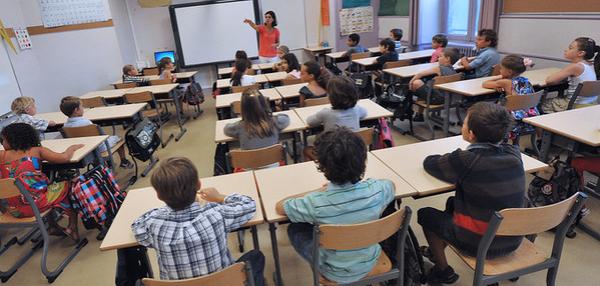
<u><em><strong>CAPTION:</strong>
<a href="https://www.altomolise.net/notizie/attualita/12962/premio-libero-grassi-2017-partecipazione-aperta-per-scuole-e-universita-molisane" target="_blank">a typical italian classroom</a>
</em></u>
Physical distancing “must always be at least one meter, desks should have plexiglas barriers or similar..” must fight with (comment by a primary school teacher) “have you seen a real class? One of those so large that even NOW there is almost no space to walk among desks?". Besides, teaching and learning depend on furniture. Individual desks with plexiglas barriers leave no space for teamwork, and little to anything but rote learning.
Time distancing, that is avoid crowding at entrance, mean that in any of the many school compounds with 800 students, entering or leaving 1 meter from each other, at ten seconds intervals, would take more than two hours to enter or leave.
The REAL role of digital contact tracing NOW
Here in Italy Immuni, the official contact tracing app, has severe bureaucratic and (for lack of a better term) “healthcare responsibility” issues that go beyond privacy, or the potential for false positives or negatives. Nothing new, but now we know it for sure. When a user is warned that she came too close to someone infected, she is the only “authority” that should immediately inform her employer and the local healthcare department, and then self-quarantine until she is tested, and test results come. This seems a binding, albeit not really explicit legal obligation, that would paralyze companies, every time any employee is just “suspect”: as things stand now, test results may take week to come. If people do not ignore the warning to remain employed, that is.
At another level, representatives of Regions criticized the fact that the app, not being integrated at all with healthcare processes, could be just bureaucratic ballast. The Governor of Veneto explicitly said that “as is, Immuni just makes an unmanageable mess and we won’t use it. The Marche Region asked his healthcare personnel to disable the app inside hospitals (that is the most infective places) to avoid high numbers of false positives.
Summarizing, the real reason to install apps like Immuni, in Italy or anywhere else, is to know exactly how to do contact tracing RIGHT in the NEXT outbreak, or pandemic.
World situation
The Facial Recognition industry suffers. First, because its main utility is reduced to measuring how many people are not recognizable, because they are responsibly wearing masks, from France to India. Second, and most ridiculous, because this bad, bad pandemic “essentially threatening the future of a multimillion-dollar industry”! Seriously (also here). What is this world coming to? How long before we see worldwide peace treaties essentially threatening the future of a multibillion weapons industry? Jeez.
Of course, researchers are already working to recognize behind masks, thanks to YOUR selfies.
Moving to less farcical concerns, it seems that as of March 31st, 2020 (that is before COVID19 had gotten out of hand there, US Consumer Debt was higher than after the 2008 meltdown. Worldwide, FMI said COVID19 can push up to 100 million people in extreme poverty worldwide.
Africa will pay a big price, that will eventually propagate to Italy, and then the rest of Europe. The continent was expecting a 3 to 5% increase in international tourists but got none so far and may lose up to 2 million jobs as a consequence, says CNN. Eventually, the african death toll directly or indirectly tied to COVID19 may reach 3 millions, also because the small farmers who feed millions of Africans are not given much attention and support.
As for “propagation”, here is what it already means:

COVID19 means that there is no more patroling of Mediterraneans, to rescue refugees or block human traffickers. Italy is not a Place of Safety anymore, and debates with Malta who is worst at saving migrants. Also, migrants who do reach italian coasts must pass the quarantine period on the same boats they barely came with. Lybia is such a mess that even migrants are routed to Tunisia, from where they continue to depart, and die. Sometimes unseen, sometimes impossible to not see. On Easter, there were 250 people at sea, calling for help, but nobody rescuing them. This week, a boat made to carry no more than 20 people capsided with 53 passengers off the coast of Tunisia.
Closing with even more general issues…
- Worldwide, different generations see different worlds with COVID19. This Is Not Good.
- Allow me a “Told You So” moment: three months ago, I observed that a 2020 serious recession was in the cards well before COVID19. In April and May, it was Nouriel Roubini to re-explain, obviously better than me, that ten major forces will lead us into a “Greater Depression”, forces that were “already looming large before Covid-19”.
- Personally, the idea of an unconditional basic income, to let human beings recover, let the economy (except “survival” activities, of course) remain in stand-by, and give institution at all levels the time to design from scratch an economy that makes sense (or, as someone just said in the US “defund and redesign everything” continues to look less expensive and more rational than any of the alternatives. But even if I’m wrong, it’s sad to see that the most institutional figure saying that society (before the economy) does not need “restarting” as much as a “Great Reset” is… Prince Charles.
(*) the title of this post is…
…inspired, with gratitude, by this tweet by Christine Hall:
I'm starting to think of Marco Fioretti as the Edward R. Murrow of the 21st century with his "This Is Italy" reports: Did COVID19 come one year too late? | Stop at Zona-M @mfioretti_it https://t.co/WBpp5g1pgm
— Christine Hall @BrideOfLinux@mastodon.opencloud.lu (@BrideOfLinux) April 18, 2020
If you agree, please do support these and future reports, as well of the rest of my work and blogging, by donations or in these other ways.
Who writes this, why, and how to help
I am Marco Fioretti, tech writer and aspiring polymath doing human-digital research and popularization.
I do it because YOUR civil rights and the quality of YOUR life depend every year more on how software is used AROUND you.
To this end, I have already shared more than a million words on this blog, without any paywall or user tracking, and am sharing the next million through a newsletter, also without any paywall.
The more direct support I get, the more I can continue to inform for free parents, teachers, decision makers, and everybody else who should know more stuff like this. You can support me with paid subscriptions to my newsletter, donations via PayPal (mfioretti@nexaima.net) or LiberaPay, or in any of the other ways listed here.THANKS for your support!